

North Anna Nuclear Powe Plant reactor units that shuts down after the facility lost power after the 5.9 earthquake that struck Virginia are now venting steam. The facility went to backup power after the earthquake and 1 of the 4 diesel generators that supply backup power failed.
The North Anna Nuclear plant is built to handle earthquakes and the 5.9 earthquake did not exceed the stated maximum capacity (5.9-6.1) of the construction this time.

There are two “loops” of steam/water in a nuke plant. One is “hot” meaning it comes in contact with the core and is radioactive. This is heated by the core and goes to a heat exchanger, usually under pressure so it is not boiling or steam. That heat exchanger connects to the other loop of water that gets its heat from the heat exchanger. This is usually transported to the turbins as steam, turning the turbines and those turn the generators. After the generators it goes to another heat exchanger that condenses it back to water and the second loop continues. There is a third heat exchanger loop usually that extracts the residual heat from the second loop helping to condense the steam.
When the plant shuts down and the generator turbines are “free wheeling” there is still heat in the core or “hot” water system that has to be removed through the heat exchanger and the second loop. The second loop is not pushing the turbines, so the heat removal is not efficient enough to cool the second loop. Steam is looping too fast to let the heat exchangers work efficiently. Therefore the second loop has to vent the system as steam to get enough cooling. The second loop is not radioactive unless there is a leak in the system.








No comments:
Post a Comment